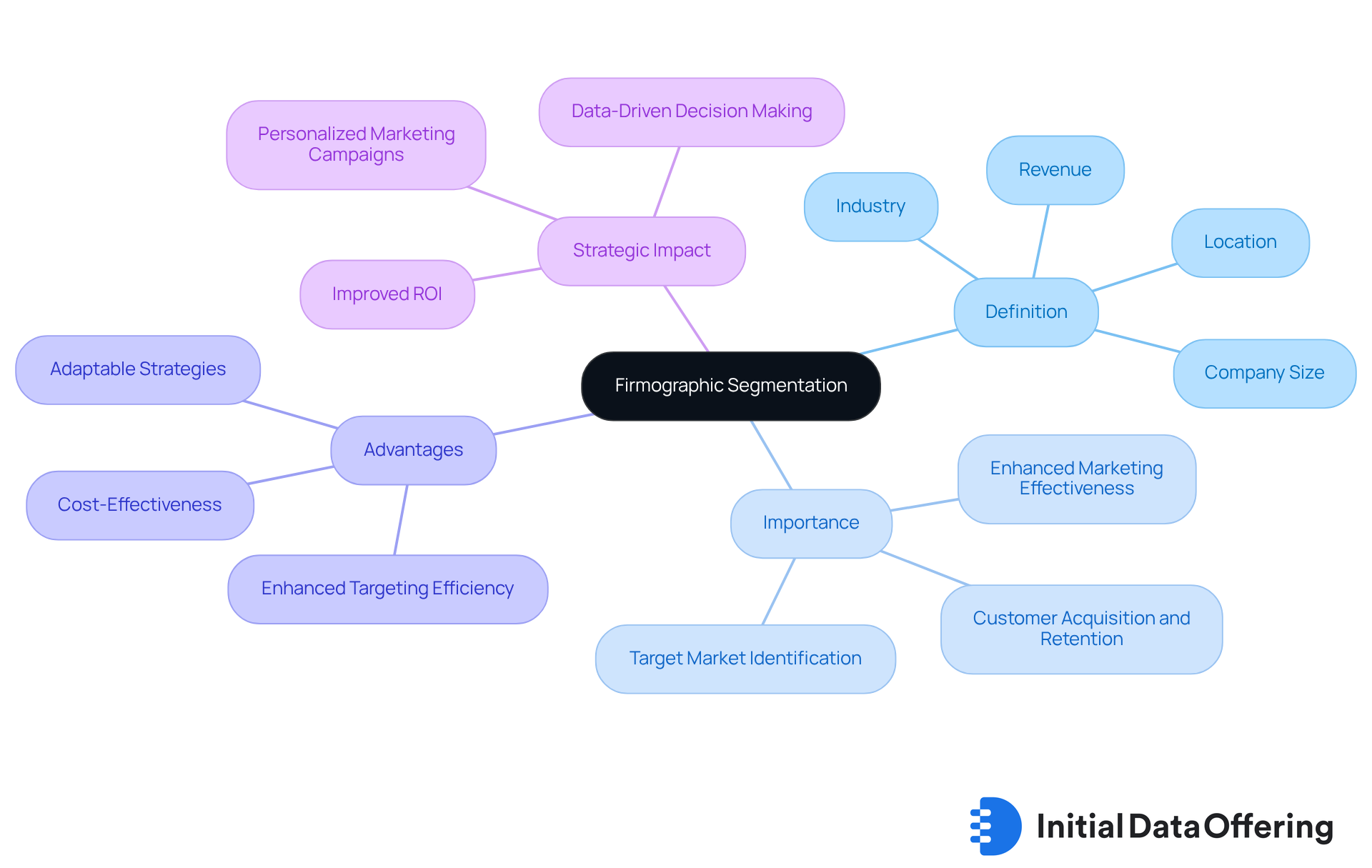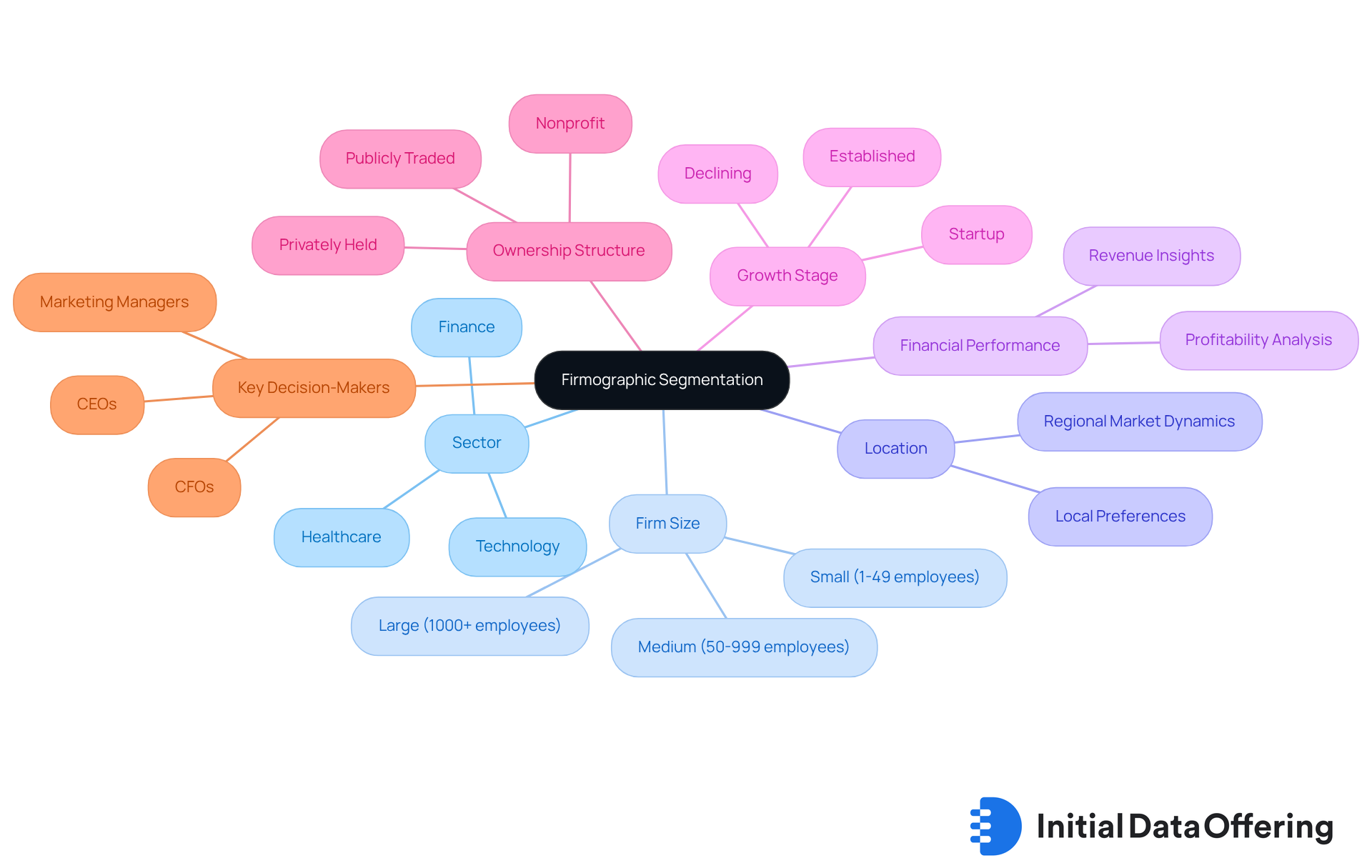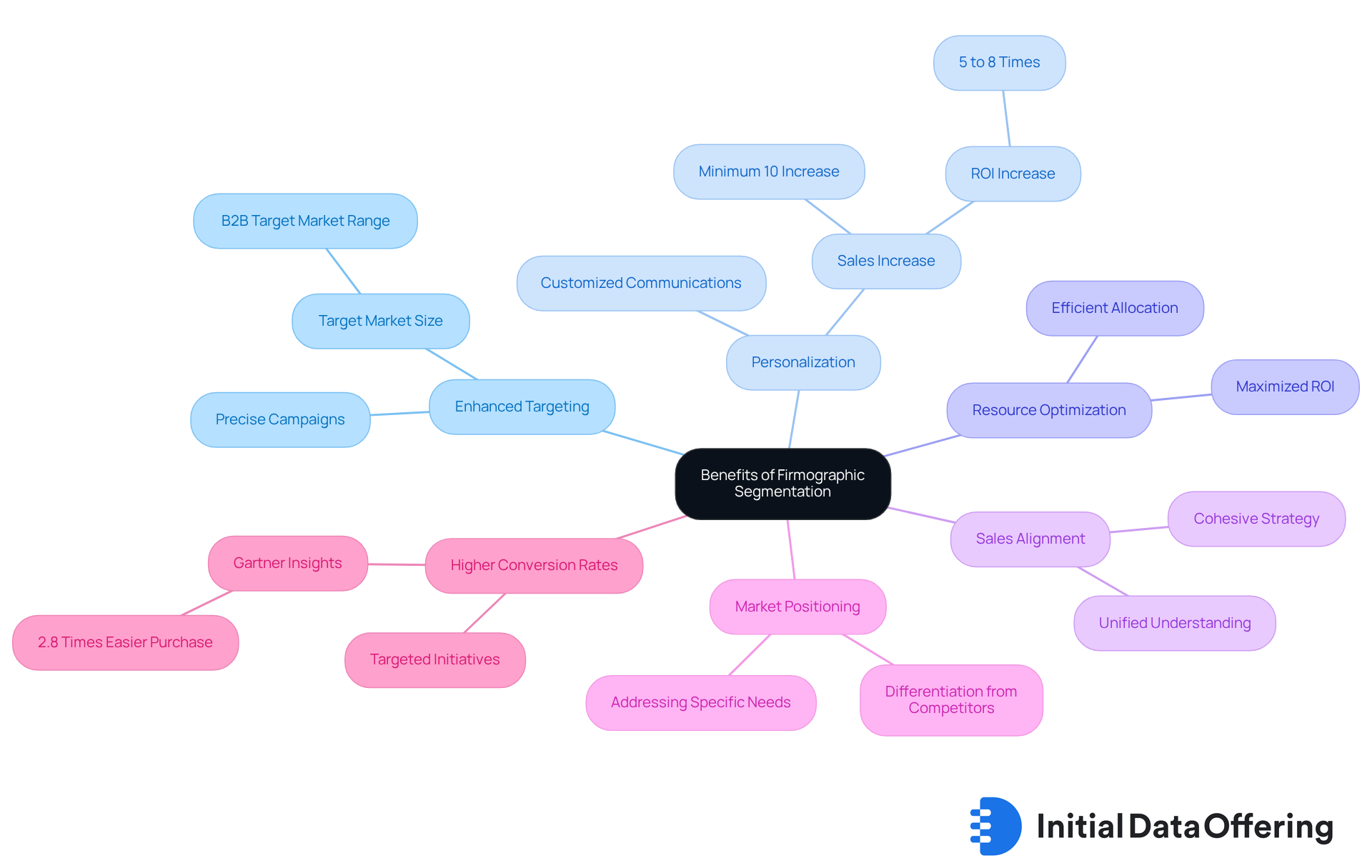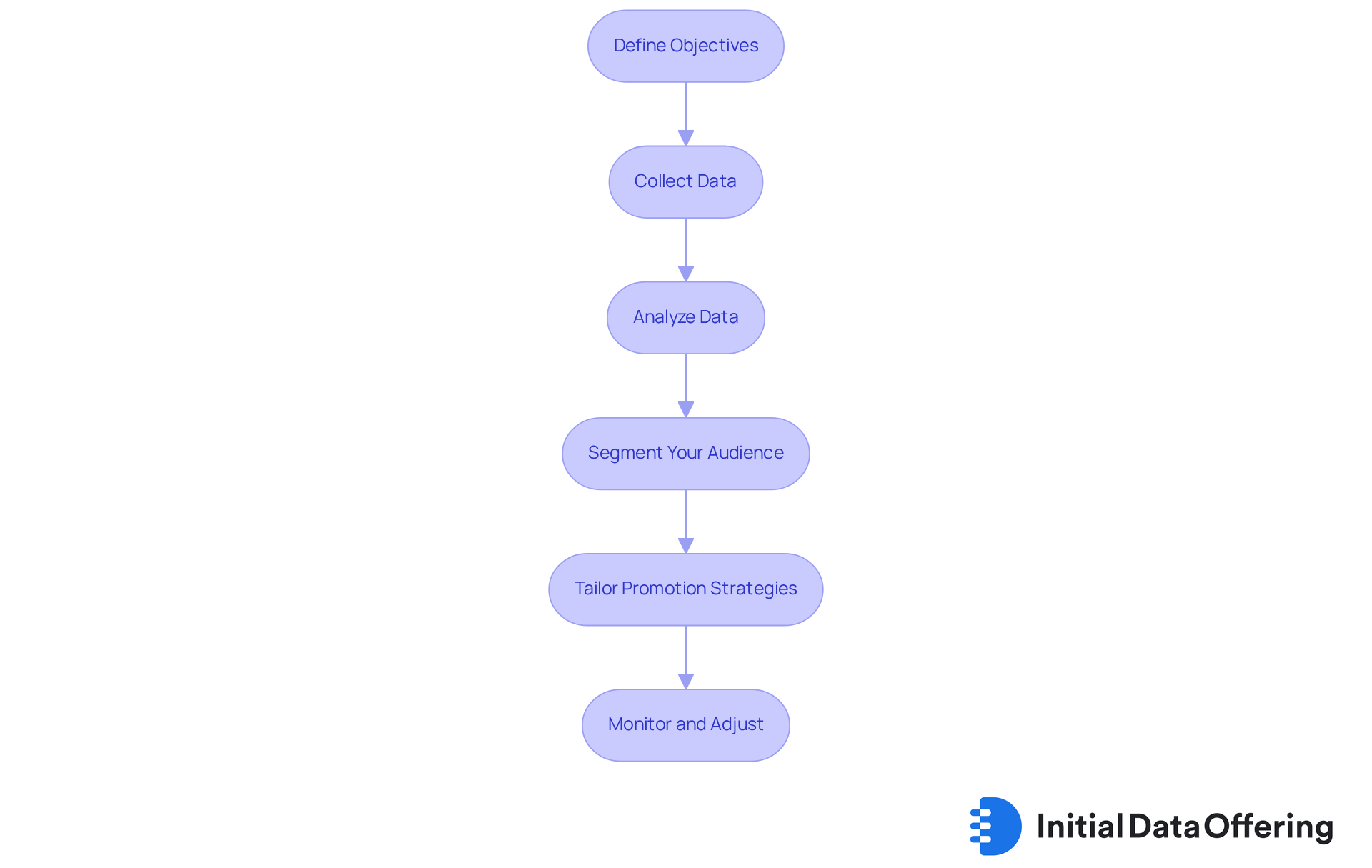4 Key Practices for Effective Firmographic Segmentation

4 Key Practices for Effective Firmographic Segmentation
Overview
Firmographic segmentation serves as a strategic approach that classifies organizations based on shared characteristics such as industry, company size, and location. This classification is essential for B2B marketers aiming to effectively target their audience. By understanding these segments, marketers can tailor their strategies to meet the specific needs of different organizations.
The article outlines four key practices for implementing firmographic segmentation:
- It emphasizes the importance of clearly defining objectives, which provides a roadmap for successful segmentation.
- Collecting and analyzing data is crucial; it allows marketers to gain insights into their target audiences.
- Tailoring promotional strategies based on this analysis enhances marketing effectiveness.
- Continuously monitoring efforts ensures that strategies remain relevant and impactful, ultimately driving better business outcomes.
How can these practices be applied in your marketing efforts? By integrating firmographic segmentation into your strategy, you can enhance your targeting precision and improve engagement with your audience.
Introduction
The landscape of B2B marketing is evolving. The ability to effectively segment organizations based on firmographic characteristics has become a game-changer. By leveraging firmographic segmentation—analyzing factors such as industry, company size, and revenue—businesses can tailor their marketing strategies to resonate with specific audiences. This targeted approach enhances engagement and conversion rates, ultimately leading to more successful marketing outcomes. However, amidst the promise of increased effectiveness lies a critical question: how can organizations navigate the complexities of firmographic data to optimize their outreach and truly connect with potential clients?
Define Firmographic Segmentation and Its Importance
The strategic classification of organizations based on shared characteristics such as industry, company size, revenue, and location is known as firmographic segmentation. This method of firmographic segmentation is crucial for B2B marketers, as it enables them to pinpoint and effectively target specific market segments. By gaining insights into the unique attributes of various organizations, businesses can tailor their promotional messages and strategies, ensuring they resonate with their intended audience. This tailored approach not only enhances engagement but also significantly boosts conversion rates.
In the competitive environment of 2025, where personalized promotion is essential, the implementation of firmographic segmentation can result in enhanced customer acquisition and retention. Recent trends suggest that companies utilizing firmographic segmentation are experiencing enhanced promotional effectiveness. Studies indicate that targeted campaigns can result in up to 2.8 times greater ease of purchase for buyers. Successful instances are plentiful, with companies employing this approach to improve their outreach and boost their overall return on investment.
The main advantages of firmographic segmentation include enhanced targeting efficiency, cost-effectiveness, and the capability to adjust strategies based on the specific requirements of various company segments. As industry specialists highlight, comprehending firmographic segmentation is crucial for developing effective campaigns that connect with prospective clients. How can your organization leverage firmographic data to enhance its marketing efforts? Consider the potential impact on your outreach and engagement strategies.

Identify Key Variables for Firmographic Segmentation
To effectively implement firmographic segmentation, businesses should concentrate on several critical variables that can greatly improve their marketing strategies.
-
Sector: Classifying companies by their primary sector—such as healthcare, finance, or technology—enables customized promotional strategies that address specific sector needs. This approach is essential, as 68% of B2B buyers conduct their own research before engaging with sales representatives, highlighting the importance of relevant content. Leveraging SavvyIQ's AI-powered data solutions provides deeper insights into industry trends and dynamics, enhancing targeting precision.
-
Firmographic segmentation, measured by employee count or annual revenue, enables businesses to effectively target small, medium, or large enterprises. Understanding the size of potential clients can lead to more personalized marketing efforts, improving engagement and conversion rates. SavvyIQ's extensive database helps identify and categorize companies based on size, facilitating more effective outreach.
-
Location: Geographic segmentation enhances targeting by considering regional market dynamics and preferences. This is particularly relevant for businesses looking to adapt their offerings to local demands, as location can significantly influence purchasing behavior. Employing SavvyIQ's data APIs offers real-time insights into regional trends, enabling more localized promotional approaches.
-
Gaining insights into a company's financial performance through firmographic segmentation helps identify potential clients that align with your product offerings. This comprehension can guide resource distribution and promotional strategies, ensuring efforts are directed toward high-potential segments. SavvyIQ's Recursive Data Engine continuously enriches financial data, enabling businesses to make informed decisions based on revenue insights.
-
Understanding the growth stage of a company through firmographic segmentation—whether it is a startup, well-established, or in decline—guides promotional strategies and communication. Tailoring communications based on a company's lifecycle stage can enhance relevance and effectiveness. SavvyIQ's data solutions assist in monitoring growth stages, offering valuable context for marketing approaches.
-
Understanding a company's ownership structure through firmographic segmentation—whether it is privately held, publicly traded, or a nonprofit—can influence engagement strategies. This knowledge allows for more targeted outreach, aligning messaging with the organization's structure and goals. SavvyIQ's comprehensive entity resolution capabilities clarify ownership structures, aiding in strategic planning.
-
Firmographic segmentation involves identifying key decision-makers within organizations, which streamlines outreach efforts and improves conversion rates. Understanding the roles of executives, like CEOs or Marketing Managers, allows organizations to create messages that connect with the appropriate audience. SavvyIQ's data infrastructure assists in identifying these key individuals, improving the efficiency of promotional campaigns.
By concentrating on these factors and utilizing SavvyIQ's sophisticated data solutions, including the Initial Data Offering as a center for high-quality datasets, companies can create a more accurate and efficient division approach, ultimately resulting in enhanced promotional results and greater ROI.

Explore Benefits of Effective Firmographic Segmentation
Effective firmographic segmentation provides numerous advantages that can greatly improve marketing strategies and business outcomes.
-
Enhanced Targeting: By examining the unique traits of different segments, companies can create promotional campaigns that are precisely tailored to connect with their specific audiences. This targeted approach ensures that messages reach the right people at the right time. For instance, B2B companies may have a target market ranging from a dozen to a few hundred prospects, underscoring the importance of precise targeting in segmentation efforts.
-
Enhanced personalization through firmographic segmentation allows companies to customize their communications, fostering more personalized interactions. This level of customization boosts engagement, as clients feel that their unique needs and preferences are recognized. In fact, personalization can increase sales by a minimum of 10%, highlighting the effectiveness of tailored promotional initiatives.
-
Resource Optimization: Focusing on high-potential segments allows businesses to allocate their promotional resources more efficiently. This strategic approach not only maximizes return on investment (ROI) but also ensures that efforts are concentrated where they can yield the greatest impact. It is essential to maintain consistent data validation and ongoing assessment of segmentation methods to sustain effective segmentation.
-
Increased Sales Alignment: When sales and marketing teams share a unified understanding of target segments, collaboration improves significantly. This alignment fosters a cohesive strategy that enhances overall sales performance, as both teams work towards common goals.
-
Better Market Positioning: By identifying and addressing the specific needs of different segments, businesses can strengthen their market position. Differentiating themselves from competitors allows them to better meet customer demands and expectations.
-
Higher Conversion Rates: Targeted and personalized promotional initiatives often lead to elevated conversion rates. Prospective clients are more likely to engage when they feel understood and valued. According to Gartner, purchasers who received useful information were 2.8 times more likely to experience enhanced ease of buying, emphasizing the impact of effective targeting on conversion rates.
These advantages underscore the essential role of firmographic segmentation as a foundational approach in B2B marketing, fostering both engagement and growth. However, organizations must remain vigilant about common pitfalls, such as data quality issues and the necessity for continuous monitoring, to avoid misguided strategies.

Implement Steps for Successful Firmographic Segmentation
To effectively implement firmographic segmentation, businesses should follow several key practices that improve their marketing initiatives.
-
Define Objectives: Establish clear goals for your firmographic targeting efforts. For instance, enhancing lead generation or improving customer engagement are vital objectives. This foundational step ensures that all subsequent actions align with your strategic vision, providing a clear direction for your efforts.
-
Collect data by accumulating accurate and comprehensive firmographic segmentation from trustworthy sources. These sources may include public records, industry reports, and customer databases. Regular updates are crucial; firmographic data should be refreshed at least monthly or whenever significant changes occur in the market or company landscape, ensuring that your strategies remain relevant and effective.
-
Analyze Data: Utilize analytical tools to uncover patterns and insights within the collected data. This examination is crucial for guiding your categorization approach and recognizing high-value groups that can enhance promotional results. Well-executed segmentation should consistently produce a higher percentage of qualified leads, ultimately driving better outcomes for your campaigns.
-
Segment Your Audience: Based on the insights gained, categorize your audience into distinct segments that share similar characteristics, such as industry, company size, and geographic location. This targeted method enables more effective promotional strategies, allowing you to tailor your messaging to specific audience needs.
-
Tailor Promotion Strategies: Create personalized promotional campaigns for each segment, ensuring that messaging aligns with their specific needs and preferences. Personalization can significantly enhance engagement; studies show that tailored experiences can increase ROI on marketing spend by 5 to 8 times and sales by at least 10%. How can you leverage this information to improve your marketing efforts?
-
Monitor and Adjust: Continuously track the effectiveness of your targeting efforts. Regularly review engagement metrics and be prepared to adjust your strategies based on feedback and results to optimize effectiveness. Additionally, consider using professional data providers to mitigate risks associated with ethical and legal concerns. Be aware that over-segmenting can lead to inefficiencies and insufficient opportunities, which may hinder your overall success.
By adhering to these structured steps, businesses can enhance their marketing initiatives through the use of firmographic segmentation. This approach ultimately drives improved results and fosters stronger connections with their target audiences.

Conclusion
Firmographic segmentation emerges as a vital strategy for B2B marketers aiming to enhance their outreach and engagement efforts. By categorizing organizations based on shared characteristics such as industry, size, and location, businesses can create tailored marketing strategies that resonate with specific market segments. This approach not only increases the relevance of promotional messages but also significantly boosts conversion rates. Thus, it becomes a cornerstone of effective marketing in the competitive landscape.
The article delves into the key variables that underpin successful firmographic segmentation, including:
- Sector classification
- Company size
- Geographic location
- Financial performance
- Growth stage
- Ownership structure
- Identification of decision-makers
Each of these factors plays a critical role in refining marketing strategies. They ensure that resources are allocated efficiently and that communications are personalized to meet the unique needs of different segments. The benefits of implementing firmographic segmentation are manifold: enhanced targeting, improved resource optimization, and higher conversion rates all contribute to a stronger market position.
Ultimately, the significance of firmographic segmentation cannot be overstated. As businesses navigate an increasingly complex market, leveraging this approach allows for more effective targeting and engagement. This fosters deeper connections with potential clients. Organizations are encouraged to embrace these practices and continuously refine their segmentation strategies. By doing so, they can unlock the full potential of their marketing efforts, paving the way for sustained growth and success in the B2B landscape.
Frequently Asked Questions
What is firmographic segmentation?
Firmographic segmentation is the strategic classification of organizations based on shared characteristics such as industry, company size, revenue, and location.
Why is firmographic segmentation important for B2B marketers?
Firmographic segmentation is crucial for B2B marketers as it enables them to pinpoint and effectively target specific market segments, allowing for tailored promotional messages and strategies that resonate with the intended audience.
How does firmographic segmentation enhance marketing effectiveness?
By gaining insights into the unique attributes of various organizations, businesses can create tailored campaigns that improve engagement and significantly boost conversion rates.
What are the benefits of implementing firmographic segmentation?
The benefits include enhanced targeting efficiency, cost-effectiveness, and the ability to adjust marketing strategies based on the specific requirements of different company segments.
What impact does firmographic segmentation have on customer acquisition and retention?
In a competitive environment, implementing firmographic segmentation can lead to improved customer acquisition and retention by facilitating personalized promotions.
What recent trends are observed in companies using firmographic segmentation?
Recent trends indicate that companies utilizing firmographic segmentation are experiencing enhanced promotional effectiveness, with targeted campaigns resulting in up to 2.8 times greater ease of purchase for buyers.
How can organizations leverage firmographic data for marketing?
Organizations can leverage firmographic data by adjusting their outreach and engagement strategies to better connect with prospective clients, thus enhancing their marketing efforts.